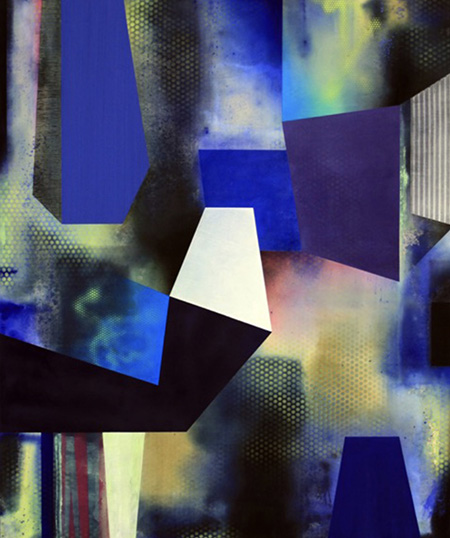
Continuing through May 26, 2018
From their very first look at or into any one of Kelly Berg’s dynamic mixed media relief-paintings, gallery goers will find themselves instantly transported into a sublimely mythical and visually magical landscape. Indeed, each work oozes with a sense of separateness or otherness that the 19th century German poet, playwright and philosopher Friedrich Schiller called schien, and which he believed represented the essential quality of any work of art. Berg’s pieces also possess what the Spanish poet Garcia Lorca dubbed duende, translated by this writer as a dark and fiery soulfulness that cannot fail to inspire art making.
Take for example the alluring and somewhat terrifying “Edge of the World.” In it a receded shadowy acrylic painting of a volcano spewing golden lava rises upward out of the gooey globed folds of a plaster and cloth constructed “ground.” Berg paints these materials as well in alchemical acrylic gold and shapes them three-dimensionally via a meshed aluminum wire armature. At once a celebration and a cautionary tale about the autonomy and potency of nature’s force, the piece also pulses theatrically with Wagnerian accents and potent spiritual and psychological depths.
Another riff on Earth’s shapeshifting fecundity is “Mysteries of Inner Earth,” tinged this time with a Van Gogh-like unbridled exuberance. Spikes are built up out of gold acrylic paint spout and support rays of sharply protruding and mirrored plastic shards that surround the work’s central image of a small pyramid set in a forest of stalactites and stalagmites. The artist has rendered this etching-like image via what she calls a “scratchboard technique,” and there’s a fetishized/sexualized dance between the introverted lines of “drawing” and the brazen dimensional surfaces of paint and plastic that protrude around and surround them.
The remaining works in the show consist of several other highly molded and textured reliefs, some iridescently and alluringly hued. A few two-dimensional acrylic paintings round out a show that honors the earth’s fierce and protean shape-making genius, while accommodating the metaphor of the human psyche and the dangerous depths to which it readily lends itself.
In the adjacent galleries, Ned Evans’ colorful and masterly executed acrylic and mixed-media geometric abstractions treat us to a painterly turbo-charge bouquet of color, texture, composition and feeling.
The artist uses multiple wood panels in these paintings, to which he affixes pre-cut geometrically shaped pieces of cloth, paper, plastics and other fabrics. All are seamlessly assembled. Evans textures many of these strips, squares and other rectangular materials with granulated sand-like additives (similarly to Tapies, Dubuffet, Braque and others). If many viewers will miss seeing the underlying cohesive element at work here in the midst of the constructivist Boogie Woogie movement and kaleidoscopic blur, they will certainly, if only subconsciously, feel it.
There’s also a studied color field tone poem feeling to Evans’ compositions that is counterbalanced by a jazz musician’s improvisational, supple and swift decision-making process. When integrated by the artist’s experienced eye and hand the combined gestalt of these elements, which meet the eye so simply yet represent a high order of visual organization, the paintings possess Schiller’s schein.
The gallery director’s office walls support a small group of Evans’s Cubistic sculptural reliefs titled “Keyholes.” Each consists of four blocks of thick foam painted with resin and encaustic oils. These frame more than encircle small, centrally positioned empty spaces, the “Keyholes,” and while feeling childlike and tender the pieces trigger the double entendre of piano keys. One can almost hear Thelonious Monk-like clunky iconic and ingenious solos emanating from them. Such serenading adds a welcome background accompaniment to the primary bodies of work in the main galleries.
